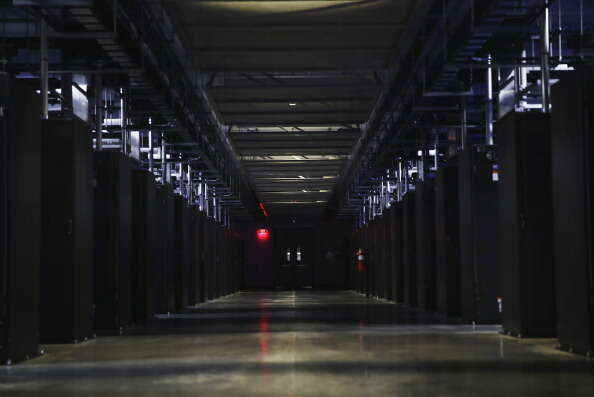
Cloud computing users, whether they are consumers, developers or enterprise IT departments, rarely consider where their data is stored. But, of course, these cloud services have a physical presence – one that is growing, as demand for cloud services increases.
Tech Monitor has mapped out the locations of data centres operated by the seven biggest cloud providers in the market: Amazon Web Services (AWS), Google, IBM, Microsoft, Oracle, Alibaba, and Tencent. This reveals where ‘the cloud’ is really located, and where the hyperscale cloud providers are building their new facilities.

Unsurprisingly, the majority of data centres are located in well-known capital cities and financial hubs: places like London and Frankfurt, Sydney and Singapore where high volumes of transactional data places a premium on efficiency among cloud computing providers.
However, concerns about sustainability are leading cloud providers to consider new locations previously overlooked for their distance from the financial action. This includes countries such as Mexico and Saudi Arabia, where solar power offers a cheap and renewable source of energy capable of accommodating their rapacious electricity needs.
How data centre locations are decided
Until recently, three main priorities have informed where the leading cloud providers have chosen to locate their data centres: regulatory risk, proximity to demand, and the absence of environmental dangers.
The first has become a significant consideration for the sector in the past few years, explains Accenture’s cloud infrastructure engineering lead Emma Roscow, as the EU ensures global players take extra steps to guarantee that the personal data of its citizens is protected.
“The European Union alone has 27 countries and 24 languages, several with their own local jurisdictions and regulations over how companies should collect, store and process data,” she says. “Many require personal data of citizens to be processed within its borders, making the data centre’s location crucial to compliance.”
But the most important consideration when running a data centre is arguably its uptime, adds Roscow. “Cloud providers have targets and guarantee uptime as high as 99.995% in some cases,” she says. Geography, therefore, is a key factor. “Areas that are at a higher risk of natural disasters are unsuitable, as there is too much of a risk that an incident could take it offline for long periods of time.”
Where are data centres located?
It should therefore be unsurprising that the largest concentration of cloud data centres in Europe are to be found in Germany, with the majority of them located in Frankfurt.
All of the seven cloud providers analysed have established data centres in the city, according to locations data provided by Netskope. Blessed with mild weather all year round, Frankfurt’s prospects as a cloud computing hub are also boosted by its hosting one of the most developed internet exchange points in the world, fuelled by the massive demand for fast data transfers that have accompanied Frankfurt’s development into a financial powerhouse.
“Certain applications require data to be processed as close to real-time as possible, particularly areas such as financial services,” Roscow explains. “Traditional business hubs are therefore always likely to remain key locations for data centres so that services are not restricted by latency issues.” Other global financial hubs like London also have a high concentration of cloud data centres, with six of the seven biggest cloud providers setting up across the capital.
Cloud providers have also set their sights on building new data centres in other European capitals. Google data centres are planned for Milan and Turin, while Microsoft is looking to expand in Warsaw and Zurich. Amazon is also planning on a new data centre in Zurich, as well as in Madrid.
Meanwhile in the Asia-Pacific region, Australia boasts one of the highest concentrations of data centres operated by the Big Seven, with a total of 21 spread across Melbourne, Sydney, and Canberra.
Part of the reason for this is the country’s ambitious ‘cloud-first’ strategy launched back in 2014, which mandated the use of cloud services in the public and private sector. Today, more than half of all businesses in Australia are using paid cloud services, and there are public commitments to ensure that all government agencies in New South Wales have a quarter of their ICT services hosted on a public cloud by next year.
Singapore has also embarked on a ‘cloud-first’ digital transformation effort, with significant results to show for it. To date, the city-state hosts data centres from all of the seven big cloud providers and has the highest number of data centres in Southeast Asia, according to the data.
This is largely due to the launching in 2018 of a national five-year project aiming to migrate the bulk of government IT resources from on-premises infrastructure to the public cloud. According to Singapore’s government technology agency, more than 600 systems are now hosted on the cloud.
New hotspot locations for data centres are emerging
Big tech has also played a significant role in upgrading Singapore’s cloud capabilities. In February, Microsoft announced a partnership with the innovation arm of the government’s security agencies to develop a ‘sovereign cloud’ which can reportedly provide high-speed network connectivity and advanced analytics for the use of real-time data, thereby enabling "swifter incident response and decision-making".
But other, more isolated areas are also beginning to emerge as ideal locations to host data centres. This pivot, explains Infiniti IT’s service manager Henry Ettinger, is attributable in large part to “concerns over the supply of renewable energy, and what can be done to lower their carbon footprint”.
In March, Microsoft announced the completion of a new data centre in Mexico’s Querétaro state, a place the company described as the ‘new data centre hotspot in Latin America’ and a ‘hub for industry 4.0’ in the region. Querétaro also boasts all of the features associated with other international cloud hotspots, including advanced local network infrastructure, proximity to important economic centres, and low seismic activity.
The coastal desert town of Dammam in Saudi Arabia is another area that other cloud providers are setting their sights on. In December 2020, Google announced it was preparing to launch a cloud region in the country, with Dammam being announced last year as the location for the company’s first data centre in the country.
The region’s ongoing boom in smart city projects and the city’s proximity to several subsea cables, including the Global Cloud Xchange’s Falcon and the Trans Europe Asia System, also makes it an ideal location for cloud hyperscalers.
Where cloud providers are building green data centres
Building infrastructure that requires constant cooling processes in a desert town like Dammam might seem counterintuitive - until one considers just how much solar power can be sourced in the Arabian Desert nearby. It's potential that’s already being realised in the construction of new solar plants in the region by the Saudi government, intended to supply the region with up to a gigawatt of cheap, renewable energy. In theory, this could also lead to improved data centre sustainability and reduce the environmental impact.
“Historically, data centres have been located in colder climates due to the lower costs associated with cooling and ventilation,” says Roscow. Rising energy costs amid a changing climate, however, are pushing cloud providers to consider new places in which to house their server racks. These considerations will only become more pronounced over time, adds Roscow, with demand for large-scale data centres predicted to increase 14% year-on-year.
Solar isn’t perfect: after all, the sun shines brightest in some of the most hostile environments on this planet. Even so, says Roscow, “as we see the proliferation of cloud and different factors being prioritised by customers when choosing vendors, we may see the trend towards new locations continue.
Tech Monitor is hosting the Tech Leaders Club on 15 September. Find out more on NSMG.live






